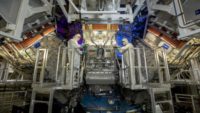Fluor Set for Contract to Develop Pilot Laser Fusion Power Plant

Engineers formerly involved with the U.S. Energy Dept.'s laser fusion energy "breakthrough" experiment last December at a California national laboratory test facility seen here now seek to develop a commercial power plant pilot using the technology, with Fluor providing preliminary design
Image: U.S. Energy Dept., Lawrence Livermore National Lab
Fluor Corp. will provide preliminary design and engineering, and is negotiating the first contract, under a memorandum of understanding with an energy developer to build a pilot power plant using laser fusion technology.
The commercialization agreement, announced April 18 by Fluor and Orinda, Calif., developer Longview Fusion Energy Systems, follows the announcement last December by the U.S. Energy Dept. that its researchers for the first time successfully produced more energy from a nuclear fusion reaction than the laser power needed to start it. The accomplishment marks a key milestone in the 60-year effort to achieve “fusion ignition.”
Longview Fusion is working on a “10- to 15-year timeline” for technical development to enable it to send 50 MW of power to the grid with a fusion pilot plant, according to Valerie Roberts, president and chief business officer.
Fluor will be Longview's engineering and construction partner to demonstrate the feasibility of laser fusion technology that can be delivered to the commercial market. “Fluor will integrate the technology into a civil project,” Roberts says, noting the firm's physics, engineering and construction expertise. “There is a little art and science of how to integrate technology into civil work,” she adds.
The companies did not release the value of Fluor's contract. “The cost for the overall project is a work in progress,” says Roberts, who adds it will be many billions of dollars.
“The Longview power plant design is based on the recent [DOE] breakthrough at the National Ignition Facility with the world’s only experimental demonstration of fusion with energy gain,” says Ed Moses, Longview Fusion CEO and former associate director of DOE's National Ignition Facility, where the breakthrough occurred. Moses has more than four decades of experience in engineering, physics, fusion technologies and laser science, including almost 30 years previously at Lawrence Livermore National Laboratory.
The company will combine more modern lasers and a patented design to replicate the National Ignition Facility’s conditions several hundred times per minute to deliver more than 1 million horsepower.
Longview will use the physics implemented at the national facility and reduce it to scale, Roberts says, adding that the accessible worldwide market for the technology is very large.
At full capacity, Longview’s full-scale laser fusion power plant would have a capacity between 1 GW and 1.6 GW, the company says. It could be used to provide power to the grid or process heat or power for industrial production of steel and hydrogen fuel among other products.
The company’s fast-track timeline will cut decades off the typical commercialization process by using materials and products available today, says Roberts, who was a DOE construction manager for the National Ignition Facility, completed in 2009.





